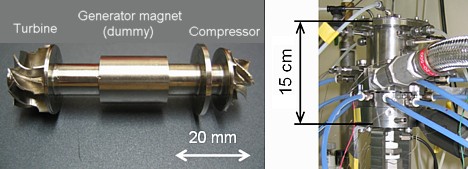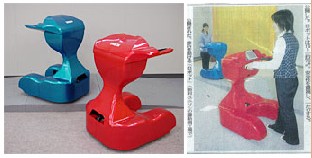
Researchers at Tohoku University have developed a working prototype of what they are calling the world's smallest gas turbine engine, a palm-sized motor they hope will one day be used to power autonomous robots and serve as a portable engine for personal transportation devices.
The research team led by professor Shuji Tanaka from Tohoku University's Nano-Precision Mechanical Fabrication Lab worked with researchers from IHI Corporation and the University of Tokyo to create the tiny engine, which measures 10 cm (4 in.) in diameter and 15 cm (6 in.) in length. With a 16 mm (0.63 in.) compressor rotor diameter and a 17 mm (0.67 in.) turbine rotor diameter and combustion chamber, the engine boasts a rotational speed of 500,000 to 600,000 rpm, which is made possible by special air bearings the researchers developed.
Unlike battery-powered engines that need to stop for periodic recharging, gas turbine engines can run continuously as long as fuel is supplied. Furthermore, gas turbine engines feature a higher power density than fuel cell and battery-powered engines, and they run cleaner than reciprocating piston engines.
With demand expected to increase for robots that use commonly available fuels and compact motors for personal transportation for the elderly, the Tohoku University researchers have been working with IHI since 2000 to develop a portable, lightweight and quiet engine able to operate for long periods of time between refuelings. After 7 years of work, they have broken the 20 mm diameter rotor barrier, a goal long shared by their microturbine-minded peers around the globe.
The engine has not yet been outfitted with a generator because it is still under development, but space has been set aside for it within the engine.
The engine will be officially unveiled at PowerMEMS 2007 scheduled for November 28-29 in Freiberg, Germany.
[Source: Nikkei Net]


 Walking Partner Robot is the second creation from the team responsible for the Partner Ballroom Dance Robot, which includes Tohoku University robotics researchers Kazuhiro Kosuge and Yasuhisa Hirata. The goal was to apply the Partner Ballroom Dance Robot technology, which perceives the intended movement and force of human footsteps, to a robot that can play a role in the realm of daily life. The result is a machine that can perceive its surroundings and provide walking assistance to the elderly and physically disabled.
Walking Partner Robot is the second creation from the team responsible for the Partner Ballroom Dance Robot, which includes Tohoku University robotics researchers Kazuhiro Kosuge and Yasuhisa Hirata. The goal was to apply the Partner Ballroom Dance Robot technology, which perceives the intended movement and force of human footsteps, to a robot that can play a role in the realm of daily life. The result is a machine that can perceive its surroundings and provide walking assistance to the elderly and physically disabled.